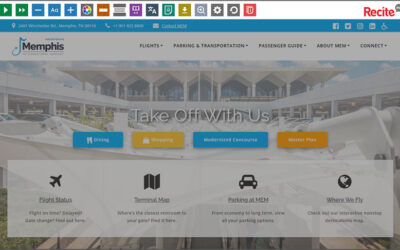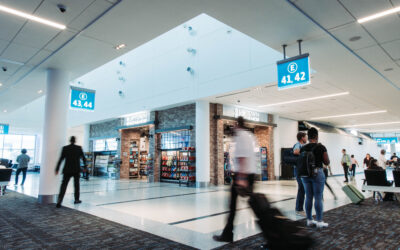Shortly before Airport Wireless was ready to move forward in the build-out of its Techshowcase store in the first phase of Raleigh-Durham International’s (RDU) Terminal 2, the company lost its funding for the project. Iris Goldschmidt, CEO of Wellington, Fla.-based APW Holdings, says she didn’t know where she was going to find an alternative funding source when a program offered by RDU came to her attention.
“They were really proactive,” Goldschmidt says of the airport, which last spring offered her a loan through the local Citizens Bank, underwritten by RDU. “It couldn’t have happened at a better time, because that’s when the banks started closing all the credit lines.” Goldschmidt ended up borrowing more than $300,000 to build out her store.
Although the timing of the loan offer might indicate it was a response to a downturn in passenger traffic due to the nation’s economic crisis, RDU officials say the loan program was in the works long before the economy collapsed last year.
“It really was coincidental that we were finishing our program at the time when companies would need it the most,” says Ingrid Hairston, business development officer at RDU. “We really were focused on ensuring that if we offer a small company an opportunity to lease here, that they’re able to realize it.”
RDU’s Outreach
The Shops of RDU Landing Small & Emerging Business Assistance Program was envisioned a few years before the economic crisis hit, when airport officials began planning for the new Terminal 2 facility that opened in October.
Hairston says the airport’s goal was to move away from its previous model of leases with prime concessionaires and instead mix in some direct leases with small companies. Under a prime model, the prime concessionaire often offers assistance to subtenants in the form of expertise, guidance and access to capital. It was the latter that most concerned RDU officials.
In the April issue, ARN published the first part of the following roundtable discussion about how airports and concessionaires can build stronger partnerships during challenging times. Some of the key points covered in the first part of the discussion included clear communication of program goals from the very beginning; understanding that each partnership if very different and information sharing is key; having regular meetings to discuss the current situation and troubleshooting difficult areas; having agreed-upon objectives; striving to understand the counterpart’s circumstances; and being flexible and creative about original contract provisions.
The following is a continuation of that discussion. Pauline Armbrust moderated, and discussing the issues are John Cugasi, concessions director, Hartsfield-Jackson Atlanta International; Scott Kilgo, senior manager of concessions development, Port of Portland; Jay Kruisselbrink, vice president BAA Pittsburgh Inc.; Richard Chinsammy, vice president of business development, Westfield Concession Management; Gerald Savaria, president and CEO, HDS Retail North America; Robert Stanton, vice president of business development, Delaware North Cos.; Iris Goldschmidt, president and CEO, Airport Wireless; and Carla Wytmar, director of development and marketing, Vino Volo.
Armbrust: Gerry, you are located in several airports all over North America. What response are you getting from airports where your sales may be declining?
Savaria: It comes back to trust. We’ve been approaching our airports and are looking at what the critical issue is, whether it is a P&L issue or a cash-flow issue, because there will be two different solutions. If we have capital investments that are coming up, maybe they can be delayed or postponed until 2010 – at least to a point where we can better gauge traffic. There are cases in older leases where we actually have a security deposit instead of an LC. That could be flipped easily into an LC and free up that cash, because obviously with the security deposit the cash is just sitting somewhere.
One issue we haven’t talked about yet, maybe because it’s a ‘sacred cow,’ is street pricing, especially in the case where we’ve joined the specialty retail and news and gift operations together in one package. The news and gift portion will typically pull together the economics of the package because on the specialty retail – once you factor in the cost of build-out, the opening hours, the franchise fees and all that stuff – operating margins are very thin. In today’s world, the news and gift is not pulling together that package; the news and gift is sinking, as well. So you have to act on that and there may be some flexibility, in terms of pricing, as a way to provide some form of relief.
At one of our airports where street pricing is the most strictly monitored, we conducted our own surveys and found that customers/travelers were still feeling that the airport was more expensive. That’s just the way it is, maybe because the $25 parking rate threw off that impression. I don’t know what it is but the bottom line is that we’re strictly street priced, have less operating margins as a result, but not getting the benefit from it, from a perception point of view.
Kilgo: We have had street pricing for 20 years and probably closer to true street pricing than anybody but it has caused a challenge. That is why you go back to what I started with, which is you have to be working toward a common goal; be clear with that. We adjust our business terms and we adjust our expectations so that coming in the door everything is known. One of our pizza concepts uses high-end flour they have off-airport to make their pizzas here. Well, the cost of that has gone up over 100% in the last year, so they have raised their prices off-airport. In response to that, the airport prices have risen, too, because they are tied to that. I’m not as concerned about street pricing because we’re tied to the market. If our off-airport counterparts are raising their prices, it’s a simple raise at the airport.
Chinsammy: We preach street pricing or fair pricing at Westfield. It’s a little hard for us to reconcile in an economic downturn where everyone is cost conscious to adjust prices where the perception has always been that we’ve always had exorbitant prices in our environments. We have to be careful with the pricing structure in our environment. That being said, we still have a lot of people going through airports. The drops are significant, yes, but I would argue that the capture rate this industry has experienced has not been over 50%. I don’t think there’s any operator airport in North America that captures 50% of the exposed enplanements.
So we’re challenging our operators, and we’re challenging our tenants to be more creative in marketing – to give the consumer a value for their money, the money that they’re really holding tightly in their fist today. How do you do that? I think you do it through customer service, you do it through marketing programs, but we’ve got to be careful about pricing. Scott, I love what you said: Adjust based on street prices. You probably do market baskets on a regular basis now, more regular than in the past, but there are adjustments out there that need to be made. But I want to be very careful with it; I think we all need to be careful with it.
Read the entire article in the upcoming June issue of Airport Revenue News.
Click Here to subscribe to Airport Revenue News.





